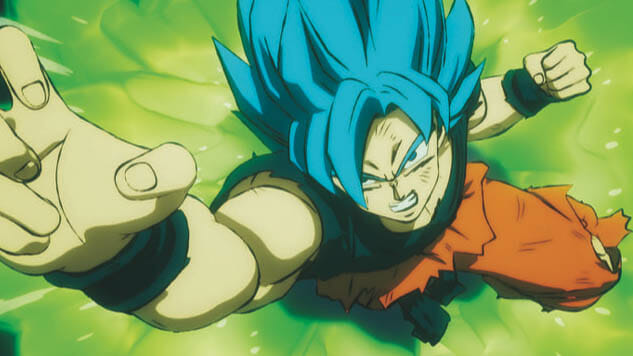Dragon Ball Super: Broly
Images via Funimation
What can be said of Dragon Ball now that hasn’t already been said several times over in the past three decades? An a shonen adventure classic-turned-international phenomenon from the moment the series made landfall in West during the ’80s, the enduring significance and popularity of Akira Toriyama’s magnum opus is beyond reproach. Acknowledged as one of the preeminent and influential works of Japanese animation of its era, the spikey-haired, gi-wearing silhouette of Son Goku, Dragon Ball’s protagonist, has become all but a universal shorthand for anime as whole to not only a generation of anime enthusiasts and earnest neophytes, but even among that of the most disinterested of befuddled onlookers.
The conclusion of Dragon Ball Super—the latest installment in the Dragon Ball series—in March of last year saw its heroes triumphant in the wake of a deadly contest of multiversal proportions. Dragon Ball Super: Broly, the direct follow-up to Super’s final episode and the first Dragon Ball film to carry the series’ name, follows Goku, Vegeta and co. faced with yet another existential threat, this time in the form of a mysterious Saiyan warrior with an unprecedented level of destructive potential.
To cut to the chase: Dragon Ball Super: Broly is impressive, for several reasons apart from even that of the quality of the film itself. When it was initially announced in December of 2017, the film was a contemporary reimagining of the eighth feature-length installment in the Dragon Ball Z film series, Broly – The Legendary Super Saiyan, released in 1993 and directed by Shigeyasu Yamauchi (alternatively known for his work as series director of the 2008 anime Casshern Sins). Toriyama, though credited with the principal design of the character, was for the most part uninvolved with the production of the original film and so, after learning years later of the character’s enduring popularity among Dragon Ball fans, took it upon himself to recreate the character to his liking and introduce him into the canon of Dragon Ball proper.
This wouldn’t be the first time in Dragon Ball’s history of a non-canon character being later recognized within the main series itself (e.g., Garlic Jr. from Dragon Ball Z: Dead Zone received his own eponymous arc in the Dragon Ball Z anime), nor would it potentially be the first case of an ostensibly non-canon character introduced via one of the series’ films to later be incorporated into the series’ accompanying manga (Goku’s father, Bardock, holds that distinction). What is exceptional in the case of Dragon Ball Super: Broly is that it’s the first instance of a non-canon character having amassed so much popularity among the Dragon Ball fanbase decades after their debut that it warranted the character’s wholesale reinvention and reintroduction into the series by none other than Toriyama himself. That alone raises interesting questions with regards to the past and prospective future of the franchise, to say nothing of the chance of yet even more non-canon characters seeing their due in the series one day.
-

-

-

-

- Curated Home Page Articles By Test Admin October 21, 2025 | 3:10pm
-

- Curated Home Page Articles By Test Admin October 21, 2025 | 2:57pm
- Urls By Test Admin October 21, 2025 | 2:57pm
- Curated Home Page Articles By Test Admin October 21, 2025 | 2:55pm
-

-

-

-

-

-

-

-

-

-

-

-

-

-

-

-

-

-

-

-

-

-

-

-

-

-

-

-

-

-

-




































